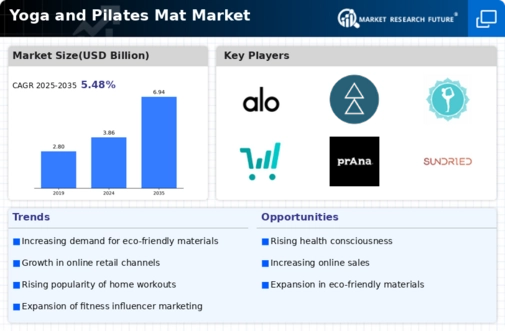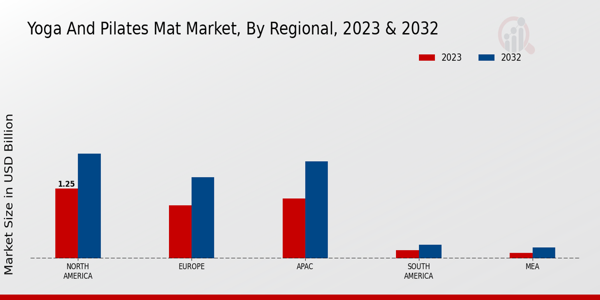Diverse Product Offerings
The Global Yoga and Pilates Mat Market Industry benefits from a wide range of product offerings catering to various consumer preferences. Manufacturers are innovating with materials, thickness, and designs to meet the diverse needs of practitioners. For instance, eco-friendly mats made from natural rubber or jute are gaining popularity among environmentally conscious consumers. This diversification not only attracts a broader audience but also encourages repeat purchases as consumers seek to try different styles. The projected CAGR of 5.48% from 2025 to 2035 indicates that this trend of varied product offerings will likely continue to play a crucial role in market expansion.
Influence of Social Media
Social media platforms significantly influence consumer behavior in the Global Yoga and Pilates Mat Market Industry. With the rise of fitness influencers and online yoga classes, consumers are increasingly exposed to yoga and Pilates practices, which in turn drives demand for mats. Platforms like Instagram and YouTube showcase various styles and techniques, encouraging followers to invest in quality mats for their practice. This digital engagement not only boosts brand visibility but also fosters a community around yoga and Pilates, further propelling market growth. As social media continues to evolve, its impact on consumer purchasing decisions is expected to remain substantial.
Market Growth Projections
The Global Yoga and Pilates Mat Market Industry is poised for substantial growth, with projections indicating a market value of 3.86 USD Billion in 2024 and an anticipated increase to 6.94 USD Billion by 2035. This growth trajectory suggests a compound annual growth rate (CAGR) of 5.48% from 2025 to 2035. Such figures reflect the increasing popularity of yoga and Pilates as fitness modalities, alongside the rising consumer investment in quality mats. The market's expansion is likely to be driven by various factors, including health trends, product innovation, and the growing presence of fitness facilities.
Rising Health Consciousness
The increasing awareness of health and wellness among consumers is a primary driver for the Global Yoga and Pilates Mat Market Industry. As individuals prioritize physical fitness and mental well-being, the demand for yoga and Pilates mats is likely to surge. This trend is reflected in the projected market value of 3.86 USD Billion in 2024, indicating a robust interest in fitness-related products. Furthermore, the emphasis on holistic health practices encourages more people to engage in yoga and Pilates, thereby expanding the consumer base for mats. This growing health consciousness is expected to sustain the market's growth trajectory in the coming years.
Expansion of Fitness Centers
The proliferation of fitness centers and studios globally contributes significantly to the Global Yoga and Pilates Mat Market Industry. As more facilities incorporate yoga and Pilates classes into their offerings, the demand for high-quality mats increases. This trend is particularly evident in urban areas where fitness culture is thriving. The anticipated growth of the market to 6.94 USD Billion by 2035 underscores the impact of fitness centers on mat sales. Additionally, many fitness centers are investing in premium mats to enhance the user experience, which may further drive consumer preferences towards specialized products in the market.
Increased Focus on Home Workouts
The trend towards home workouts is reshaping the Global Yoga and Pilates Mat Market Industry. As more individuals opt for exercising at home, the demand for yoga and Pilates mats is likely to rise. This shift is supported by the availability of online classes and instructional videos, making it easier for consumers to practice at home. The convenience of home workouts appeals to a wide demographic, including busy professionals and parents. Consequently, the market is expected to see sustained growth, with projections indicating a potential increase in value to 6.94 USD Billion by 2035 as more consumers invest in home fitness equipment.
























